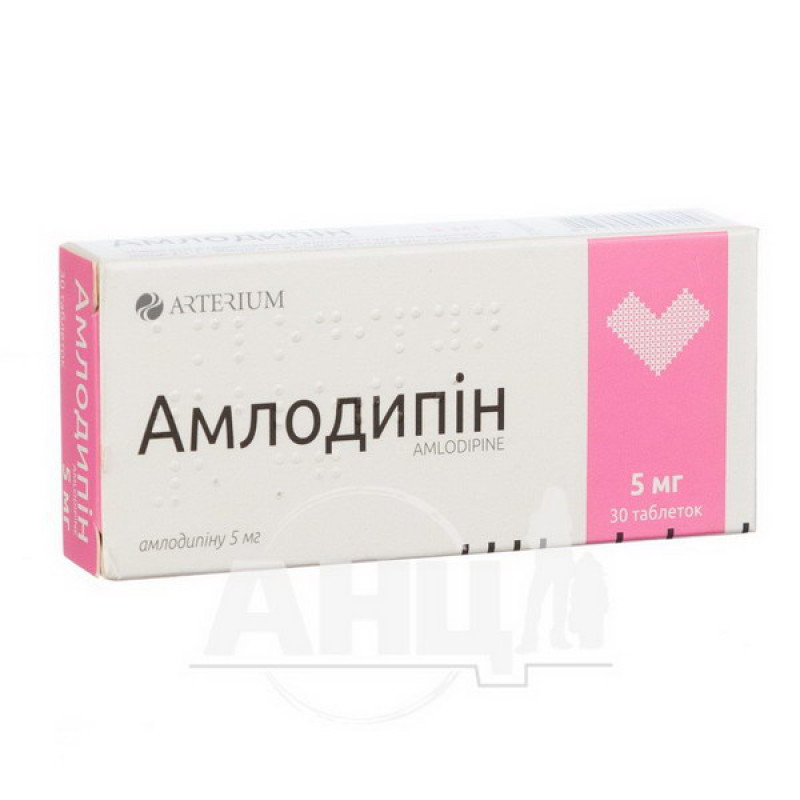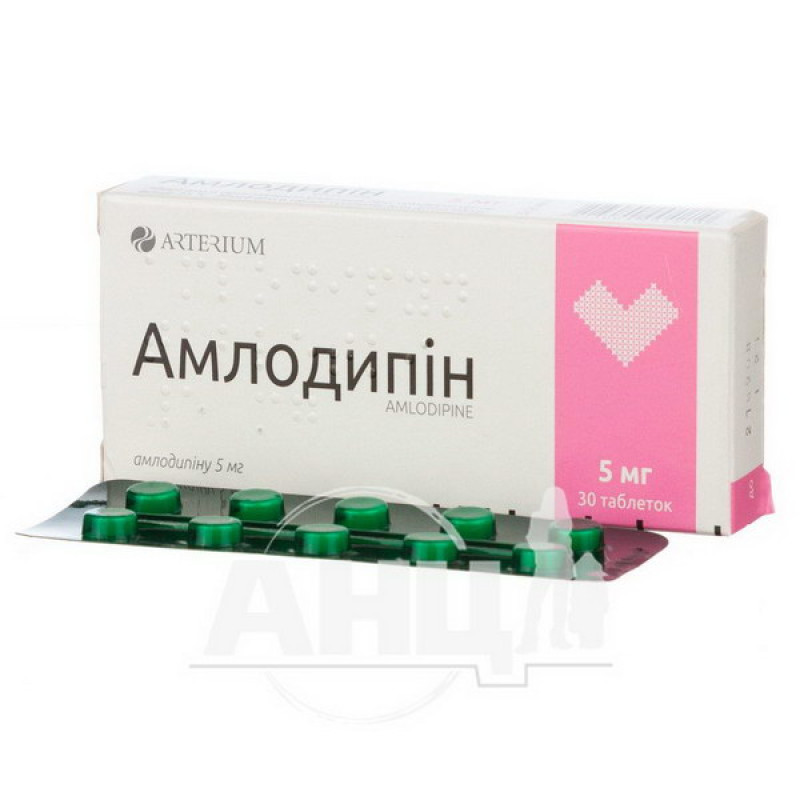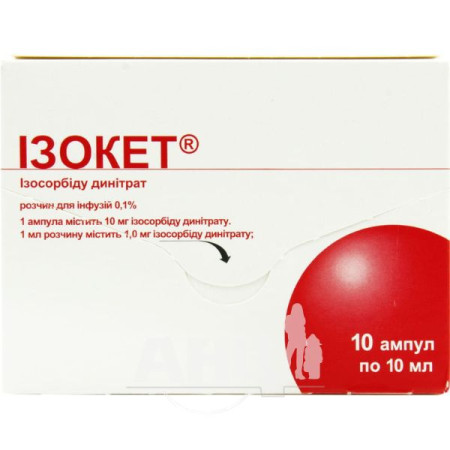Amlodipine tablets 5 mg No. 30

Pharmacological properties
Pharmacodynamics. Amlodipine is a calcium antagonist (dihydropyridine derivative) that blocks the entry of calcium ions into the myocardium and smooth muscle cells.
The mechanism of the hypotensive action of amlodipine is due to a direct relaxing effect on vascular smooth muscle. The exact mechanism of the antianginal effect of amlodipine is not sufficiently understood, but the following effects play a role:
1) amlodipine dilates peripheral arterioles and thus reduces peripheral resistance (afterload). Since the heart rate remains stable, the reduction in workload on the heart leads to a decrease in energy consumption and myocardial oxygen demand;
2) Dilation of the main coronary arteries and coronary arterioles (normal and ischemic) may also play a role in the mechanism of action of amlodipine. Such dilation increases myocardial oxygen saturation in patients with coronary artery spasm (Prinzmetal's angina or variant angina).
In patients with hypertension, once-daily dosing provides clinically significant reductions in both supine and standing blood pressure over 24 hours. Due to the slow onset of action of amlodipine, acute hypotension is usually not observed.
In patients with angina pectoris, 1 daily dose of the drug increases the total time of physical exertion, the time to the onset of angina pectoris, and the time to reach 1 mm of ST segment depression on the ECG. The drug reduces the frequency of angina attacks and reduces the need for nitroglycerin.
Amlodipine is not associated with any adverse metabolic effects or changes in plasma lipid levels and can be used in patients with bronchial asthma, diabetes mellitus, and gout.
Pharmacokinetics
Absorption/distribution. After oral administration of therapeutic doses, amlodipine is gradually absorbed into the blood plasma. The absolute bioavailability of the unchanged molecule is about 64-80%. C max in blood plasma is achieved within 6-12 hours after administration. The volume of distribution is approximately 21 l/kg body weight; the acid dissociation constant (pKa) of amlodipine is 8.6. In vitro studies have shown that the binding of amlodipine to plasma proteins is about 97.5%. Simultaneous food intake does not affect the absorption of amlodipine.
Metabolism/Excretion. T½ from blood plasma is about 35-50 hours. Steady-state plasma concentrations are reached after 7-8 days of continuous use of the drug. Amlodipine is mainly metabolized to inactive metabolites. About 60% of the administered dose is excreted in the urine, about 10% of which is unchanged amlodipine.
Elderly patients. The time to reach steady-state plasma concentrations of amlodipine is similar in the elderly and in adult patients. The clearance of amlodipine is usually slightly reduced, which in elderly patients leads to an increase in AUC and T½ of the drug.
Patients with renal impairment. Amlodipine is extensively biotransformed to inactive metabolites. 10% of amlodipine is excreted unchanged in the urine. Changes in plasma amlodipine concentrations do not correlate with the degree of renal impairment. In patients with renal impairment, normal doses of amlodipine can be used. Amlodipine is not dialysable.
Patients with hepatic impairment. Information on the use of amlodipine in patients with hepatic impairment is very limited. In patients with hepatic insufficiency, clearance of the drug is reduced, resulting in an increase in T½ and an increase in AUC by approximately 40-60%.
Children. Typically, oral clearance in children aged 6-12 and 13-17 years was 22.5 and 27.4 l/h, respectively, for boys and 16.4 and 21.3 l/h, respectively, for girls. There is considerable variability in exposure between patients. Information in patients under 6 years of age is limited.
Indication
Ag; chronic stable angina; vasospastic angina (Prinzmetal's angina).
Application
Adults. Usually for the treatment of arrhythmia and angina pectoris, the initial dose of amlodipine is 5 mg amlodipine once a day. Depending on the patient's response to therapy, the dose may be increased to a maximum of 10 mg once a day.
In patients with angina pectoris, the drug can be used as monotherapy or in combination with other antianginal drugs in case of resistance to nitrates and/or adequate doses of β-adrenergic blockers.
There is experience of using the drug in combination with thiazide diuretics, α-adrenoceptor blockers, β-blockers or ACE inhibitors in patients with hypertension. There is no need to adjust the dose of the drug when used simultaneously with thiazide diuretics, β-adrenoceptor blockers and ACE inhibitors.
Children aged 6 years and older with hypertension. The recommended initial dose of Amlodipine for this category of patients is 2.5 mg 1 time per day. If the required blood pressure level is not achieved within 4 weeks, the dose can be increased to 5 mg/day. The use of the drug in doses of 5 mg in this category of patients has not been studied.
Elderly patients: No dose adjustment is necessary for this category of patients. Increasing the dose should be done with caution.
Use in patients with hepatic impairment: Doses for use in this category of patients have not been established (see Precautions).
Contraindication
Known hypersensitivity to dihydropyridines, amlodipine or any other component of the drug; severe arterial hypotension; shock (including cardiogenic shock); obstruction of the left ventricular outflow tract (e.g. severe aortic stenosis); hemodynamically unstable heart failure after acute myocardial infarction.Side effects
Blood and lymphatic system disorders: leukocytopenia, thrombocytopenia.
On the part of the immune system: allergic reactions.
Metabolic and nutritional disorders: hyperglycemia.
Psychiatric: insomnia, mood changes (including anxiety), depression, confusion.
Nervous system: drowsiness, dizziness, headache (mainly at the beginning of treatment), tremor, dysgeusia, syncope, hypoesthesia, paresthesia, hypertonicity, peripheral neuropathy.
On the part of the organ of vision: visual impairment (including diplopia).
From the side of the organs of hearing and labyrinth: ringing in the ears.
Cardiac: palpitations, myocardial infarction, arrhythmia (including bradycardia, ventricular tachycardia, and atrial fibrillation), as well as chest pain.
Vascular: hot flashes, hypotension, vasculitis.
Respiratory, thoracic and mediastinal disorders: dyspnea, rhinitis, cough.
On the part of the digestive system: abdominal pain, nausea, vomiting, dyspepsia, intestinal motility disorders (including constipation and diarrhea), dry mouth, pancreatitis, gastritis, gingival hyperplasia.
Hepatobiliary system: hepatitis, jaundice, increased liver enzymes (most often associated with cholestasis).
Skin and subcutaneous tissue disorders: alopecia, purpura, skin discoloration, increased sweating, itching, rash, exanthema, angioedema (Quincke's edema), erythema multiforme, urticaria, exfoliative dermatitis, Stevens-Johnson syndrome, photosensitivity.
Musculoskeletal and connective tissue disorders: peripheral edema (including shins), arthralgia, myalgia, muscle cramps, back pain.
Renal and urinary disorders: urinary incontinence, nocturia, increased urinary frequency.
From the reproductive system and mammary glands: impotence, gynecomastia.
General disorders: fatigue, asthenia, malaise.
Others: weight gain or loss.
Isolated cases of extrapyramidal syndrome have been reported.
Special instructions
The safety and efficacy of amlodipine in hypertensive crisis have not been evaluated.
Patients with heart failure. Amlodipine should be used with caution in this category of patients. In a long-term placebo-controlled study in patients with severe heart failure (NYHA class III and IV), the incidence of pulmonary edema was higher with amlodipine compared to placebo. Calcium channel blockers, including amlodipine, should be used with caution in patients with chronic heart failure, as they may increase the risk of future cardiovascular events and mortality.
Patients with impaired liver function. T ½ of amlodipine, as with other calcium antagonists, is increased in patients with impaired liver function. For this reason, the drug should be used in such patients with special caution and only under the supervision of a physician.
Elderly patients: Increasing the dose of the drug in this category of patients should be done with caution.
Patients with renal insufficiency. In this category of patients, the usual doses of the drug should be used. Changes in the concentration of amlodipine in the blood plasma do not correlate with the degree of renal dysfunction. Amlodipine is not removed by dialysis.
Amlodipine does not affect the results of laboratory tests.
It is not recommended to use amlodipine with grapefruit or grapefruit juice, as bioavailability may be increased in some patients, leading to increased hypotensive effect of the drug.
Patients with hereditary galactose intolerance, lactase deficiency or glucose/galactose malabsorption syndrome should take into account that this medicine contains lactose.
Use during pregnancy and breastfeeding. The safety of amlodipine during pregnancy has not been established.
The use of amlodipine during pregnancy is recommended only in cases where there is no safer alternative and the risk associated with the disease itself outweighs the possible harm from treatment for the mother and fetus.
It is not known whether amlodipine is excreted in human milk. A decision must be made whether to continue breastfeeding or to use amlodipine, taking into account the benefit of breastfeeding to the child and the benefit of the drug to the mother.
Reversible biochemical changes in the sperm head have been reported in some patients receiving calcium channel blockers. There is insufficient clinical information regarding the potential effect of amlodipine on fertility.
Ability to influence the speed of reactions when driving vehicles or operating machinery. Amlodipine may have a minor or moderate influence on the ability to drive vehicles or operate complex machinery. The speed of reactions may be reduced in the presence of symptoms such as dizziness, headache, confusion or nausea.
Interactions
Effects of other drugs on amlodipine
CYP 3A4 inhibitors. When amlodipine is co-administered with CYP 3A4 inhibitors such as erythromycin in younger patients or diltiazem in older patients, plasma concentrations of amlodipine are increased by 22% and 50%, respectively. The clinical significance of these data is unknown. It cannot be excluded that potent CYP 3A4 inhibitors (ketoconazole, itraconazole, ritonavir) increase plasma concentrations of amlodipine to a greater extent than diltiazem. Amlodipine should be used with caution in combination with CYP 3A4 inhibitors. However, no adverse reactions associated with the use of such a combination have been reported.
CYP 3A4 inducers. There is no information on the effect of CYP 3A4 inducers on amlodipine. Concomitant use of amlodipine and substances that are CYP 3A4 inducers (e.g. rifampicin, St. John's wort) may lead to a decrease in amlodipine plasma concentrations, therefore such combinations should be used with caution.
The use of cimetidine, antacids containing aluminum or magnesium, and sildenafil does not affect the pharmacokinetics of amlodipine.
Dantrolene (infusion): Fatal ventricular fibrillation and cardiovascular collapse associated with hyperkalemia have been reported in animals following the administration of verapamil and intravenous dantrolene. Because of the risk of hyperkalemia, it is recommended that calcium channel blockers such as amlodipine be avoided in patients predisposed to malignant hyperthermia and in the treatment of malignant hyperthermia.
Effect of amlodipine on other medicinal products
The hypotensive effect of amlodipine potentiates the hypotensive effect of other antihypertensive agents.
Clinical drug interaction studies have shown that amlodipine does not affect the pharmacokinetics of atorvastatin, digoxin, ethanol (alcohol), warfarin, and cyclosporine.
Overdose
Experience with intentional overdose of the drug is limited.
Symptoms of Overdose: Available information suggests that a significant overdose of Amlodipine will result in excessive peripheral vasodilation and possibly reflex tachycardia. Significant and possibly prolonged systemic hypotension, including shock with fatal outcome, has been reported.
Treatment: Clinically significant hypotension due to amlodipine overdose requires active support of the cardiovascular system, including frequent monitoring of cardiac and respiratory functions, monitoring of BCC and urine output; the patient should be placed in a horizontal position with the lower extremities elevated.
Vasoconstrictors can be used to restore vascular tone and blood pressure, making sure there are no contraindications to their use. The use of calcium gluconate intravenously may be useful for neutralizing the effects of calcium channel blockade.
Gastric lavage may be useful in some cases. Administration of activated charcoal to healthy volunteers within 2 hours of administration of 10 mg amlodipine significantly reduced its absorption.
Since amlodipine is highly protein bound, the effect of dialysis is negligible.
Storage conditions
In the original packaging at a temperature not exceeding 25 °C.
There are no reviews for this product.
There are no reviews for this product, be the first to leave your review.
No questions about this product, be the first and ask your question.






